4.1. Pages¶
Portfolio → Pages
A page contains a selection of artefacts which you arrange and present to others. These may include:
- selected files
- résumé details
- text (your added commentary, instructions or orientation)
- journal posts
- video and audio files
- RSS feed to an external blog
- etc.
You can re-use the artefacts that you collected under Content in as many pages as you wish.
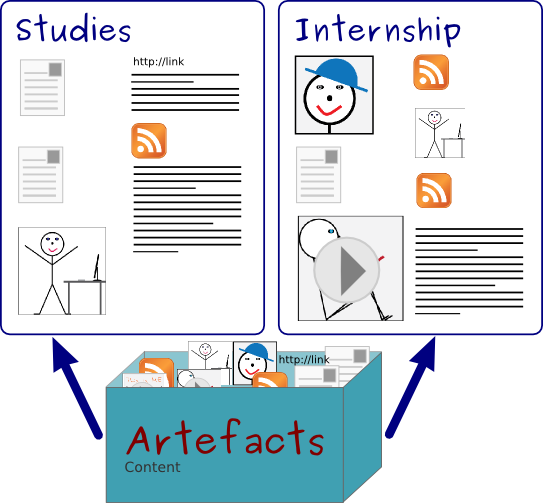
The same artefacts can appear in multiple pages
4.1.1. Overview page¶
On the landing page of the portfolio, you can do the following.
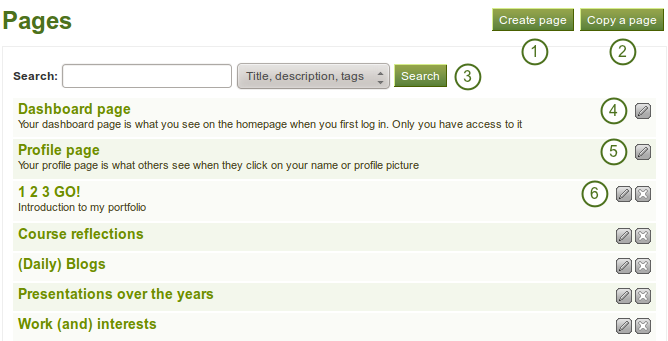
The landing page of your portfolio
- Create a new page.
- Copy a page from your portfolio or from another user.
- Search your portfolio pages.
- Edit your dashboard page.
- Edit your profile page.
- Edit or delete your portfolio pages.
4.1.2. Create a new page¶
You create a new page in your portfolio when you want to display artefacts together, e.g. for presenting it to others, for showing your progress in a project etc.
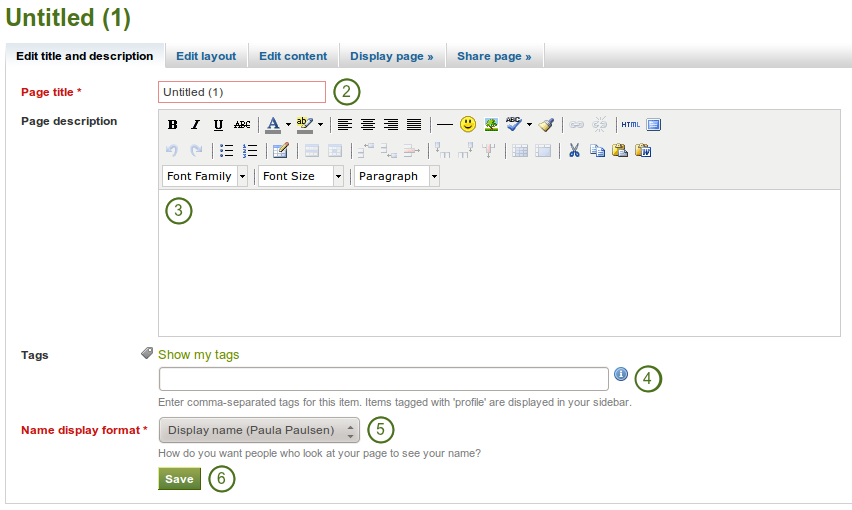
Create a portfolio page
- On the Pages page, click the Create page button.
- Page title: Provide a title for your page. This field cannot be left empty. If you do not enter a title, the default “Untitled” will appear.
- Page description: Write a brief description summarising your objective of this page. It will appear on the page itself.
- Tags: Enter tags to find your page more easily at a later stage. Separate your tags with commas. If you already have tags, you can click on the link Show my tags and select the ones that you think will fit for this page as well.
- Name display format: Choose which name you want to appear as author.
- Click the Save button to save your changes and to continue to the Edit content part.
4.1.3. Edit an existing page¶
You can edit an existing page in two ways:
- Click on the Edit button
 when you are on the Pages overview page.
when you are on the Pages overview page. - Click on the Edit this page button when you are on the actual page.
See also
You find more information on how to edit artefacts on a portfolio page in the Edit content part.
Warning
Links to external content such as embedded external videos and RSS feeds to an external blog are completely deleted when you remove the respective blocks from your portfolio page. You cannot recover them. There is no revision history. All other artefacts are not deleted when you remove them from a page because they reside in your Content area.
 From Mahara 1.5 on, text boxes (a.k.a. Notes) can be re-used in other portfolio pages.
From Mahara 1.5 on, text boxes (a.k.a. Notes) can be re-used in other portfolio pages.
4.1.4. Copy a page¶
You can duplicate your own pages or pages of other users if they allowed you to do that.
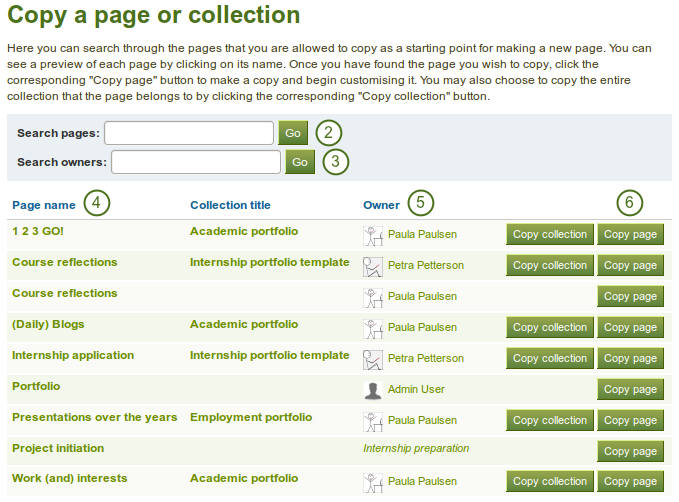
Copy a page
- Click the Copy a page button under Portfolio → Pages.
- Search pages and collections: If there are many pages from which you can choose, either search for a keyword in the page title or
- Search owners: Search for the author of the page.
- Page title: Click on the title of the page to see a preview of it before you copy it.
- Owner: Click on the name of the owner to view a larger profile picture and the self-description if the owner provided one.
- Click the Copy page button to copy the page into your own portfolio.
- Edit the page as you would do any other page.
Note
 The site administrator can decide to leave out “Copy of…” for copied pages or collections. This setting needs to be made in the config.php file. If
The site administrator can decide to leave out “Copy of…” for copied pages or collections. This setting needs to be made in the config.php file. If $cfg->renamecopies = true;, copies of new pages and collections will have “Copy of” prepended to the title.
4.1.5. View a page¶
You can view a page to check what it looks like when somebody else sees it. Go to the Pages overview page and click on the title of a page.
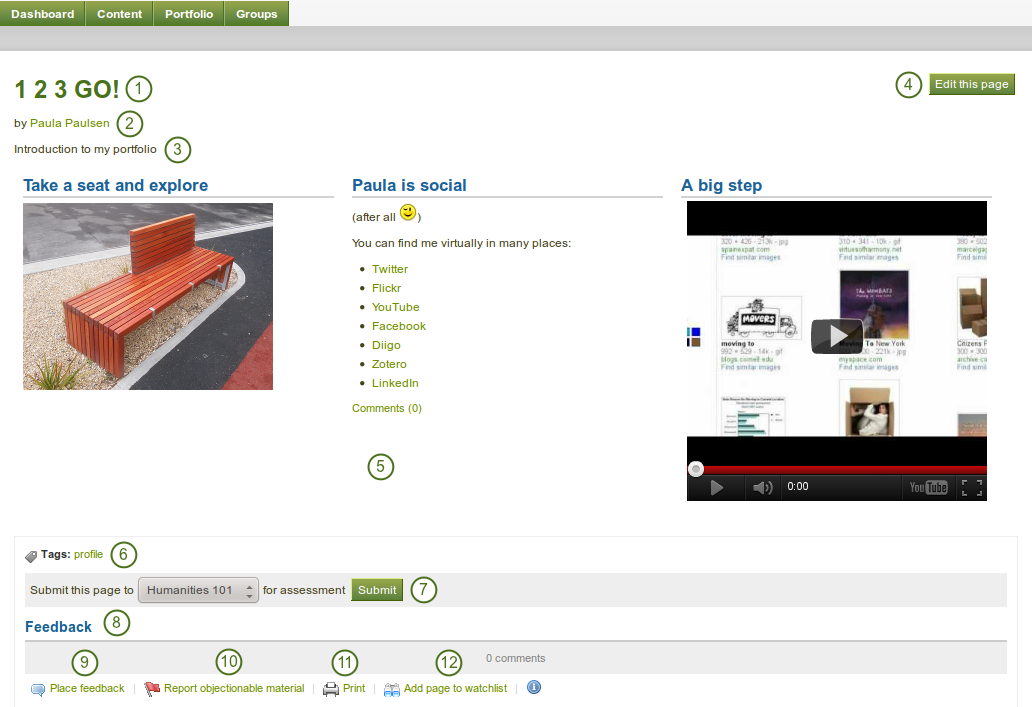
An example portfolio page. When you are the author, you can click on the Edit button and make changes.
- Title of the portfolio page.
- Author of the portfolio page.
- Description of the page.
- The Edit this page button is only visible to the portfolio author.
- The artefacts that have been placed in the page.
- Tags which you provided for your page.
- If you belong to a group which allows the submission of pages for feedback / assessment, you see the group name displayed and can submit your page directly from here. For more information see the section on feedback for assessment.
- Feedback area at the bottom of each page displays comments from users.
- Place feedback button can be used by yourself and others to leave comments on the page.
- If a page contains offensive artefacts, users can report them to the administrator.
- Print button to print the page.
- The Add page to watchlist allows you be informed when changes are made to the page.
4.1.6. Give others access to your page¶
See also
Please refer to the section on sharing your pages and collections for further information.